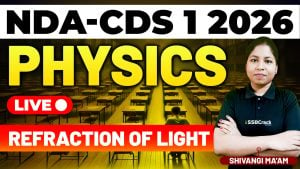The topic of Sets, Relations, and Functions forms an essential part of the National Defence Academy and Naval Academy (NDA-NA) Exam – Paper I (Mathematics). Recently, a class was conducted focusing on the subtopics of Cartesian Product, Relations, Domain and Range of Relations, and various types of relations such as Empty, Universal, Inverse, Identity, Reflexive, Symmetric, Transitive, and Equivalence Relations. This session provided a detailed understanding of these concepts, with an emphasis on how they are tested in the NDA-NA exam.
In this blog, I will share the key points covered in the class, strategies for mastering this topic, and tips for performing well in the NDA-NA exam.
Class Recap: Key Concepts in Relations and Functions
The class began by discussing relations and their connection to sets, which are foundational topics in understanding mathematical relationships and functions. Let’s go through the main points that were discussed.
1. Cartesian Product
The Cartesian product is a crucial concept for understanding relations. It refers to the set of all ordered pairs formed by combining elements from two sets. This concept is important because it forms the basis for defining relations between sets.
In the class, it was explained that the Cartesian product helps in mapping relationships between different elements. Understanding how to work with Cartesian products is essential for solving problems involving relations, particularly when dealing with ordered pairs.
2. Relations: Definition and Types
A relation is essentially a way to describe how elements from one set are related to elements from another. It is a subset of the Cartesian product and can be represented using ordered pairs. The class emphasized that understanding relations requires knowing not just the connection between sets but also the domain and range of these relations.
Domain and Range of Relations
- Domain: This is the set of all possible inputs (first elements in ordered pairs) for a relation.
- Range: This refers to the set of all possible outputs (second elements in ordered pairs) that result from the relation.
Mastering the domain and range is crucial for answering questions on relations and functions in the exam, as many problems require you to identify these sets.
3. Types of Relations
The class delved into various types of relations that are commonly tested in the NDA-NA exam. Each type of relation has specific characteristics, and understanding these differences helps in identifying the correct answer in multiple-choice questions.
- Empty Relation: A relation that contains no ordered pairs. It signifies that no elements of one set are related to any elements of the other.
- Universal Relation: A relation that includes every possible ordered pair from the Cartesian product.
- Inverse Relation: This involves swapping the elements of each ordered pair in the relation. The inverse relation is essential when solving problems that ask for reverse mappings.
- Identity Relation: A relation where each element is related to itself. For example, if an element belongs to a set, it is only related to itself in an identity relation.
- Reflexive Relation: This relation requires that every element in a set is related to itself. The reflexive property is important in understanding the behavior of sets within a relation.
- Symmetric Relation: In this type, if an element “a” is related to “b,” then “b” must also be related to “a.” This is often tested in exam questions where relationships between pairs are flipped.
- Transitive Relation: If “a” is related to “b” and “b” is related to “c,” then “a” must be related to “c.” Understanding transitive relations helps in solving chain-reaction problems in relations.
- Equivalence Relation: A relation is called an equivalence relation if it satisfies the properties of being reflexive, symmetric, and transitive. These are often tested as complex MCQs that require checking whether a relation meets all these criteria.
The discussion in the class made it clear that distinguishing between these types of relations is key for solving the different kinds of questions that are likely to appear in the NDA-NA exam.
Strategies for Preparing Sets, Relations, and Functions for NDA-NA Exam
Given the range of subtopics within sets, relations, and functions, it is important to approach your preparation with a clear strategy. Below are the essential strategies that were highlighted during the class:
1. Master the Basics of Relations and Cartesian Products
Before moving on to more advanced problems, ensure that you are comfortable with the basic concepts of relations, including the Cartesian product and how relations are formed as subsets of this product. Practice forming relations from different sets and finding their domain and range.
2. Focus on Different Types of Relations
Understanding the different types of relations—reflexive, symmetric, transitive, and equivalence relations—is critical for solving a majority of questions on this topic. A good way to solidify this understanding is by practicing problems that ask you to identify the type of relation in a given set of ordered pairs. Make sure you know the conditions that must be met for each type of relation.
3. Use Real-World Examples
Relations and functions are easier to grasp when you relate them to real-world situations. For example, think of reflexive relations as a situation where every person in a group is related to themselves, or symmetric relations as a friendship between two people that works both ways. These kinds of analogies can make abstract concepts more concrete and easier to recall in the exam.
4. Practice Identifying Domain and Range
Many questions in the NDA-NA exam require you to find the domain and range of a given relation. Practice this by working through a variety of problems where you need to extract these sets from ordered pairs. Pay close attention to questions that ask you to find the domain and range in specific scenarios, as this skill is often tested.
5. Work Through Previous Year’s Questions
One of the best ways to prepare for the NDA-NA exam is by solving previous years’ questions. This will give you a good idea of the types of relation-based questions that are typically asked. The class discussed the importance of familiarizing yourself with the question patterns, and this is particularly useful when dealing with relations, where specific types of problems tend to be repeated.
6. Time Management and Efficient Problem Solving
As with any competitive exam, time management is crucial. During your practice, focus on solving questions efficiently. Try to minimize the number of steps you take to arrive at the correct answer. For relations, this means quickly identifying the type of relation and using that information to eliminate incorrect answer choices.
7. Avoid Common Pitfalls
Students often make mistakes by confusing the properties of relations or incorrectly identifying the domain and range. Be mindful of these common pitfalls, especially when working with symmetric, transitive, or equivalence relations. Double-check your work to ensure that all conditions of a particular type of relation are satisfied before selecting your answer.
Conclusion: Strengthening Your Understanding of Sets, Relations, and Functions
The recent class on sets, relations, and functions covered fundamental concepts that are vital for success in the NDA-NA exam. By focusing on Cartesian products, types of relations, and their properties, students gained a clearer understanding of how to approach this topic in an exam context.
To prepare effectively for this section of the exam:
- Build a strong foundation by mastering the basic concepts and properties of relations.
- Practice identifying the domain and range of relations, as this is a common type of question in the exam.
- Work through past exam questions to get a feel for the format and level of difficulty.
- Focus on time management and accuracy, ensuring that you solve problems efficiently without making careless errors.
With consistent practice and a thorough understanding of the key concepts, you’ll be well-prepared to tackle any question on sets, relations, and functions in the NDA-NA exam.



















